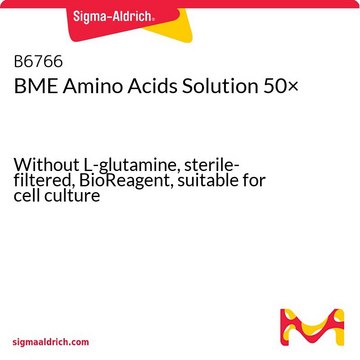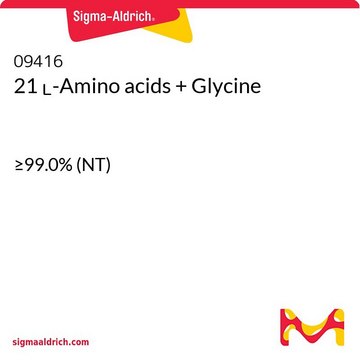R7131
RPMI 1640 Amino Acids Solution (50×)
Without L-glutamine, sterile-filtered, BioReagent, suitable for cell culture
Synonyme(s) :
Amino Acid Supplement
Se connecterpour consulter vos tarifs contractuels et ceux de votre entreprise/organisme
About This Item
Code UNSPSC :
12352209
Nomenclature NACRES :
NA.75
Produits recommandés
Niveau de qualité
Stérilité
sterile-filtered
Gamme de produits
BioReagent
Forme
liquid
Technique(s)
cell culture | mammalian: suitable
Impuretés
endotoxin, tested
Conditions d'expédition
ambient
Température de stockage
2-8°C
Description générale
RPMI 1640 Amino Acids Solution (50×) serves as an amino acid concentrate to supplement Roswell Park Memorial Institute medium (RPMI)-based mammalian cell culture media.
Application
RPMI 1640 Amino Acids Solution (50×) has been used as a supplement:
- in M9 minimal medium to culture the bacterial strains, SX701 and JE116
- to culture blood neutrophils from lactation cows in vitro
- for amino acid stimulation in amino-acid-free Roswell Park Memorial Institute medium (RPMI) medium to grow HeLa cells
Supplément
Réf. du produit
Description
Tarif
Code de la classe de stockage
10 - Combustible liquids
Classe de danger pour l'eau (WGK)
WGK 1
Point d'éclair (°F)
Not applicable
Point d'éclair (°C)
Not applicable
Faites votre choix parmi les versions les plus récentes :
Déjà en possession de ce produit ?
Retrouvez la documentation relative aux produits que vous avez récemment achetés dans la Bibliothèque de documents.
Les clients ont également consulté
Nuno Carinhas et al.
BMC systems biology, 5, 34-34 (2011-03-01)
Stoichiometric models constitute the basic framework for fluxome quantification in the realm of metabolic engineering. A recurrent bottleneck, however, is the establishment of consistent stoichiometric models for the synthesis of recombinant proteins or viruses. Although optimization algorithms for in silico
D Kazyken et al.
The Journal of biological chemistry, 297(4), 101100-101100 (2021-08-22)
The mechanistic target of rapamycin (mTOR) complex 2 (mTORC2) signaling controls cell metabolism, promotes cell survival, and contributes to tumorigenesis, yet its upstream regulation remains poorly defined. Although considerable evidence supports the prevailing view that amino acids activate mTOR complex
Preeti Ashok et al.
Frontiers in bioengineering and biotechnology, 8, 571425-571425 (2020-11-17)
Functional heart cells and tissues sourced from human pluripotent stem cells (hPSCs) have great potential for substantially advancing treatments of cardiovascular maladies. Realization of this potential will require the development of cost-effective and tunable bioprocesses for manufacturing hPSC-based cell therapeutics.
Piero Dalle Pezze et al.
Nature communications, 7, 13254-13254 (2016-11-22)
Amino acids (aa) are not only building blocks for proteins, but also signalling molecules, with the mammalian target of rapamycin complex 1 (mTORC1) acting as a key mediator. However, little is known about whether aa, independently of mTORC1, activate other
Daniel Bloch Hansen et al.
The Journal of membrane biology, 245(2), 77-87 (2012-03-03)
The present work was initiated to investigate regulation of the taurine transporter TauT by reactive oxygen species (ROS) and the tonicity-responsive enhancer binding protein (TonEBP) in NIH3T3 mouse fibroblasts during acute and long-term (4 h) exposure to low-sodium/hypo-osmotic stress. Taurine
Notre équipe de scientifiques dispose d'une expérience dans tous les secteurs de la recherche, notamment en sciences de la vie, science des matériaux, synthèse chimique, chromatographie, analyse et dans de nombreux autres domaines..
Contacter notre Service technique










